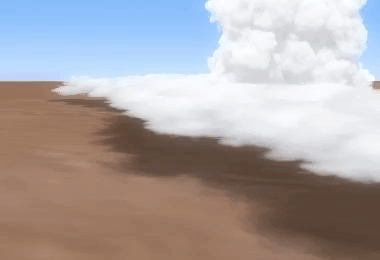Dust storms can be some of the most dramatic weather events we see in the Valley each year.
Another word for a dust storm is “haboob,” which is Arabic for the word blown.
 University Corporation for Atmospheric Research
University Corporation for Atmospheric ResearchHaboobs are giant walls of dust created from high winds rushing out of a collapsing thunderstorm.
The American Meteorology Society specifically defines a haboob as, "An intense sandstorm or dust storm with sand and/or dust often lofted to heights as high as 1500 m (~5000 feet), resulting in a “wall of dust” along the leading edge of the haboob that can be visually stunning."
During our Arizona monsoon season, cold air coming out of collapsing thunderstorms rushes down at an incredible rate, which can often pick up massive amounts of dust and sand and loft them up into the air.
As the dust storm builds, it can completely block out the sun, making it nearly impossible to see just a few feet in front of you.
MAP: Watch dust levels rise as storms roll into the Valley
The wall of dust typically reaches heights between 1,500 and 5,000 feet and can stretch as far as 100 miles wide. To put that into perspective, that's the distance between Phoenix and Tucson.
However, the Valley has seen dust storms that are even bigger. On July 5, 2011, the biggest haboob ever observed in the Valley rolled in. It was estimated at well over 5,000 feet tall and stretched the entire length of the Valley, from Goodyear to Apache Junction.
If you get caught outside during a dust storm, seek shelter immediately or you may be hurt by flying rocks and debris being thrown around by winds up to 50 mph.
If you’re driving when a dust storm hits, remember to pull off to the right, take your foot off of the brake and turn off your car’s engine and lights. Wait there until visibility improves.
The impacts of haboobs can linger for days as dust particles remain in our atmosphere. That can worsen our air quality and cause difficulty breathing for kids, older adults and people with asthma or COPD.
Breathing in dust spores from haboobs can also increase your risk of contracting Valley fever.
Valley fever is caused by the Coccidioides fungus, which grows in dirt and fields and can cause fever, rash and coughing. Winds from dust storms can transport the fungal spores that cause the disease.









